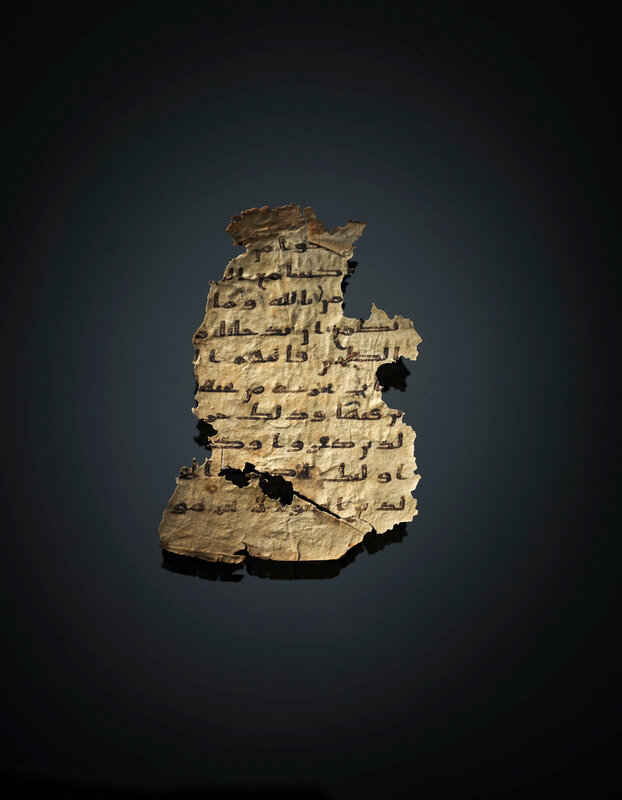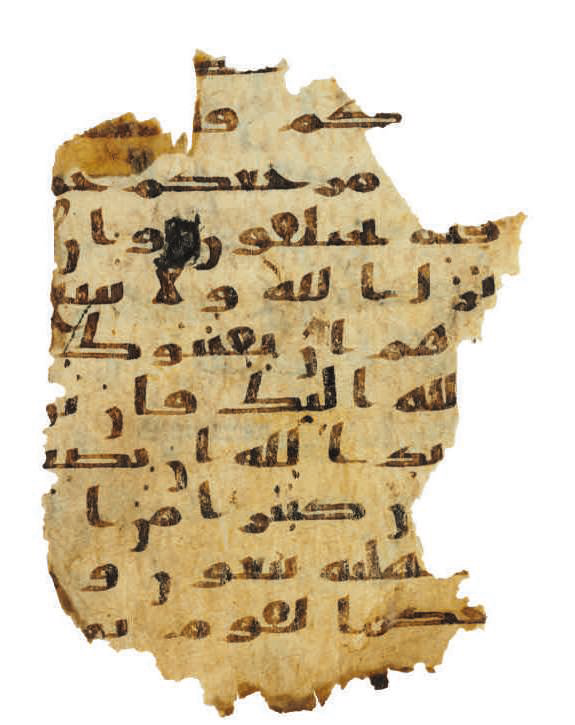Outstanding result for the only recorded Qur'an Palimpsest copied on an earlier Coptic Bible
Lot 1. An unrecorded Qur’an Palimpsest copied on an earlier Coptic Bible, probably Egypt, Second century AH-Circa 8th century AD and earlier. Estimate: £80,000 – 120,000. Price realised: £596,750. © Christie’s Images Limited 2018.
LONDON.- Christie’s announced the results achieved for the palimpsest of a Qur’an copied onto a Christian text, realising £596,790 during the Art of the Islamic and Indian Worlds Including Oriental Rugs and Carpets auction. As Lot 1 of the sale, this remarkable manuscript dates to the earliest period of Islam. The leaves from these folios derive from an earlier Coptic manuscript containing passages from the Book of Deuteronomy, which is part of the Torah and the Christian Old Testament. It was very probably produced in Egypt, home to the Coptic community, at the time of the Arab conquest. This appears to be the only recorded example of a Qur’an written above a Christian text, and the importance of this manuscript resonates with the historical reality of religious communities in the Near East and as such is an invaluable survival from the earliest centuries of Islam.
This remarkable discovery was made with the help of French scholar Dr. Eléonore Cellard, as the folios are in fact a palimpsest, a manuscript from which the first writing has been effaced so that the vellum could be reused. Beneath the Arabic script an original Coptic text may clearly be seen.
Dr. Eléonore Cellard, Postdoctoral fellowship at Collège de France, Paris “This is a very important discovery for the history of the Qur’an and early Islam. We have here a witness of cultural interactions between different religious communities.”
Eleonore Cellard is attached to the College de France, a leading academic institution based in Paris. She works under the supervision of Prof Déroche, the leading expert in the field of early Islamic scripts and early Islamic codicology.
Lot 1. An unrecorded Qur’an Palimpsest copied on an earlier Coptic Bible, probably Egypt, Second century AH-Circa 8th century AD and earlier. Estimate: £80,000 – 120,000. Price realised: £596,750. © Christie’s Images Limited 2018.
Nine folios, comprising Qur'an V, sura al-ma'ida, v.40 to v.58, v.69 to v.76, v.83 to v.88, v.116 to v.120 (some in parts only), and Qur'an VI, sura al-an'am, v.1 to v.9, on vellum, the Arabic text inscribed above passages from the Deuteronomy in Coptic, each folio with up to 11ll. of sepia later hijazi or early kufic, one folio with foliate sura heading in polychrome, each folio with areas of loss, one folio in two sections. Largest folio 4 3/8 x 5 1/8in. (11.1 x 12.7cm.)
AN UNRECORDED QUR'AN PALIMPSEST
These nine folios come from a previously unrecorded Qur’an manuscript dating to the earliest period of Islam. It is remarkable in that it is a palimpsest. Beneath the Arabic script an original Coptic text may clearly be seen. A palimpsest is a manuscript from which the first writing has been effaced so that the vellum could be reused. In our folios, the leaves derive from an earlier Coptic manuscript containing passages from the Book of Deuteronomy, which is part of the Torah and the Christian Old Testament. It was very probably produced in Egypt, home to the Coptic community, at the time of the Arab conquest. This appears to be the only recorded example of a Qur’an written above a Christian text. These folios resonate with the historical reality of religious communities in the Near East and as such are an invaluable survival from the earliest centuries of Islam.
The fact that this is a palimpsest is very significant. From late Antiquity onwards the shortage of writing material, both in the territories of the former Roman Empire and in the Byzantine world, was often severe enough to compel copyists to have revert to the practice of reusing parchment. Presumably the earlier text was scraped off the vellum, but the iron gall ink has corroded the vellum and left a clear trace (particularly visible on the folio illustrated p.11 of this catalogue, lower left).
Particular attention was paid to the fate of the Qur’anic text in its written form and amongst the ‘hundreds of thousands of Qur’anic leaves preserved [..] less than a dozen palimpsests [are known]. In other words, virtually all extant early Qur’ans were written on new parchment, despite its high cost.’ (Alain George, On An Early Qur’anic Palimpsest and Its Stratigraphy : Cambridge Or. 1287, St Andrews, Scotland, 9 July 2013, p.6). In the Greek Byzantine tradition however many palimpsests survive such as the important Archimedes Palimpsest which sold at Christie’s, New York, 29 October 1998, lot 1 (sold $2,202,500) where the extensive 10th century version of Archimedes’ text was erased to make place for a 12th century Greek text. In contrast, Qur’anic palimpsests are extremely rare and only a handful are known:
1. Two leaves from a 7th century Hijazi Qur’an, sold at Christie’s, London, 8 April 2008, lot 20 (sold £2,484,500) and 01 May 2001, lot 12 (sold for £163,250). The Qur’anic text is copied above an earlier version of the Qur’an.
2. The late 7th/early 8th century Mingana-Lewis Palimpsest (MS Or.1287) at the Cambridge University Library. The Hijazi script has been erased and the leaves were used for a 9th/10th century codex of Christian Arabic homilies produced in Palestine. The palimpsest was acquired by Agnes Smith Lewis in Suez in 1895.
3. A leaf from a 7th century Hijazi Qur’an in San’a (Masahif San’a, exhibition catalogue, Kuwait, 1983, cat.4, p.59). The surviving Qur’anic text is copied above an earlier version of the Qur’an.
4. The present folios, dating to the 8th century. The Qur’anic text is copied above an earlier Coptic text.
In his discussion of the Lewis-Mingana palimpsest, George suggests two hypothesis that remain valid in the context of our folios to explain the unusual reuse. They may have transferred ‘from one community to another through looting or some other use of force [or] the Qur’anic leaves were copied by Christian scribes’. It is attested in Traditions of the Prophet that Christian scribes copied Qur’anic leaves and that ‘followers of the Prophet had the Qur’an copied by Christian scribes in Hira, southern Iraq’ (George, op.cit.,p.6).
We would like to thank Dr. Eleonore Cellard for identifying this palimpsest manuscript and for her research on the folios.
A transition style between the ‘Later hijazi’ and ‘Early kufic’ scripts:
The angular script used to transcribe the Qur’anic text on our folios changes slightly from a folio to another, a result of the scribe’s varying hand. On some pages particularly, it demonstrates a monumental quality. Its style strongly tends towards the astonishing Qur’an section in Tashkent, one of the largest Qur’ans ever produced on vellum, dated to the 8th century (Will Kwiatkowski, Pages of the Qur’an, The Lygo Collection, London, 2013, cat.1, pp.10-11). On our folios, the script shows a purposeful elongation (mashq), a sign of the scribe’s concern for producing a visually striking script. Alifs are mostly vertical but some of them are sloping to the right, a typical feature of manuscripts commonly associated with the Hejaz region and known as hijazi. A smaller number of alifs are sloping to the left. However there is a clear base line throughout. Elegant double-eye ha(initial and medial forms) have curved top pointing to the right. The ductus can be traced with ease, as the bar and the two ‘eyes’ betray the movement of the pen. The tails of the waw sit under the line as it appears on a folio in the Nasser D. Khalili collection dated to the second half 8th century/early 9th century (François Déroche, The Abbasid Tradition, The Nasser D. Khalili Collection of Islamic Art, London, 1992, cat.4, p.48-49). Our script displays a particular idiosyncratic fa (medial position) formed by inverted drop-shaped loop that sits equally on a short vertical stem rising from the base line. It relates to a script found on another folio in the Khalili collection dated to the end of the 8th century (Déroche, ibid., cat.11).
Our script is ‘plump’ and relates to the ‘later hijazi’ styles, a style that further develops into the numerous Abbasid kufic scripts of the end of 8th and 9th century. As the hijazi style may have ‘enjoyed the incomparable prestige of being directly connected with the beginnings of Islam’ it influenced later styles of the 8th and even 9th century (Déroche, ibid., p.28).
By comparing our folios to the important group found in the ceiling of the Great Mosque of San’a in the early 1980s, we find that the style fits between the ‘Late hijazi style’ and the ‘kufic style’ suggesting a dating to the second century of Islam (the 8th and early 9th century AD). See for instance how it compares to a late hijazi folio of vertical format, also with few diacritics and no vocalization (Masahif San’a, exhibition catalogue, Kuwait, 1985, cat. 17) and to the important Umayyad Mushaf, an early second century AH manuscript in kufic style (and equally in nearly square format; Masahif San’a, ibid, cat.45). With its stout quality, thick line and short vertical strokes, rounded body of the letters, our script also relates to two folios dated to the second half of the 8th century in the Khalili Collection (Déroche, ibid, cat.5, pp.49-51).
The small square format
Although fragmentary, it is possible to reconstruct the approximate full size of these folios as some of them have occasionally retained their borders. It shows that this manuscript was nearly square and measures 11.1 x 12.7cm approximately. There are few known Qur’ans of the early centuries that are in square format and most of those are of considerable proportions. With its small square format, our Qur’an is a rarity but other small folios appear in the Mingana-Lewis Palimpsest (max. 19 x 12cm.) mentioned above. By contrast, the aforementioned Umayyad Mushaf measures 42 x 43cm whilst another nearly square 8th century juz’ in Istanbul measures 36 x 41cm (Masahif San’a, ibid, cat.45, p.45 and cat,46, p.12 and 1400. Yilinda Kur’an-I Kerim, exhibition catalogue, 2010, cat.4, pp.148-151). As on our folios, the Istanbul juz’ has a regular script, with occasional diacritics but no vocalization. This regularity is developed with great mastery in the Umayyad Mushaf which is dated to the early 2nd century AH (second quarter 8th century AD).
The illuminated sura heading
The sura heading is illuminated in a simple palette of yellow, red and green highlights applied on a sepia ink drawing. This combination is found on many other hijazi and early kufic folios. The cartouche contains a repetition of motifs resembling crescents, alternatively facing upwards and downwards, somehow related to the decoration of two early kufic pages of the San’a group (Masahif San’a, ibid, cat. 28 and cat.49). It may be a stylized version of vegetal palmettes, as discussed by Marilyn Jenkins (Masahif San’a, ibid, p.19).
Related examples at auction
For other hijazi and late hijazi Qur'an folios that sold at auction see, Christie's, London, 1 May 2001, lot 12 (dated mid-7th century and attributed to Medina); 8 April 2008, lot 20 (dated mid-7th century and attributed to Medina); 7 April 2011, lot 10 (second half 7th/early 8th century); 10 April 2014, lot 35 (dated second half 7th/early 8th century); 23 April 2015, lot 3 (dated second half 7th/early 8th century), and Sotheby's, London, 8 October 2008, lot 3 (dated second half 7th century); 22 April 2015, lot 56 (dated second half 7th century); and a close comparable example to the present folios: a folio from a large Qur'an in late hijazi script, which sold at Sotheby's, London, 3 October 2012, lot 11 (dated as late 7th/early 8th century).

/https%3A%2F%2Fprofilepics.canalblog.com%2Fprofilepics%2F1%2F0%2F100183.jpg)
/https%3A%2F%2Fstorage.canalblog.com%2F03%2F02%2F119589%2F96711876_o.jpg)
/https%3A%2F%2Fstorage.canalblog.com%2F11%2F31%2F119589%2F94773502_o.jpg)
/https%3A%2F%2Fstorage.canalblog.com%2F20%2F83%2F119589%2F94772815_o.jpg)
/https%3A%2F%2Fstorage.canalblog.com%2F26%2F72%2F119589%2F75604929_o.jpg)
/https%3A%2F%2Fstorage.canalblog.com%2F59%2F60%2F119589%2F26458628_o.jpg)












/image%2F1371349%2F20240421%2Fob_8b1ff8_437929632-1654121795357833-33075436577.jpg)
/image%2F1371349%2F20240421%2Fob_ac05d1_437909277-1654131698690176-37194240325.jpg)
/http%3A%2F%2Fstorage.canalblog.com%2F20%2F94%2F119589%2F128675984_o.png)
/http%3A%2F%2Fstorage.canalblog.com%2F78%2F84%2F119589%2F126266259_o.jpg)